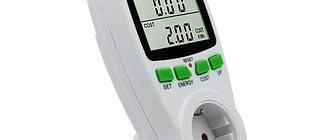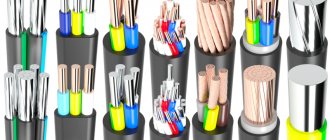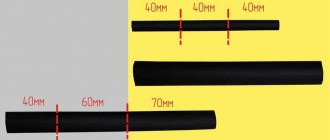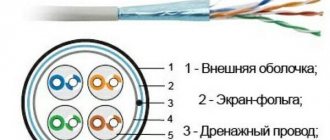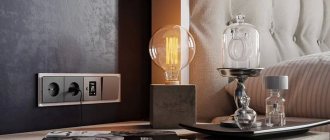The plug socket is...
A device that allows you to ensure safe connection of electrical appliances to the network at minimal cost. There is a whole range of plug sockets on the market - waterproof, grounded, dual, but the main principle of operation remains unchanged. The appliance does not function without a plug, so the size and location of the holes must be taken into account. To prevent contact with various objects, a female connector is provided.
Currently, the outdated type of wiring is being replaced, so a plug socket with a grounding contact is becoming an indispensable device. This greatly increases security.
Design features and technical characteristics
Traditionally, a plug socket consists of three elements - a housing, a block and a contact with the device.
The body performs a decorative and protective function and is made of durable, non-flammable materials. The block is the basis of the device, made of ceramic or carbolite and holds the lid and contacts. Through contacts with the device, electricity reaches the consumer. Made from various alloys. In terms of design, there are recessed and external type devices. In the first case, there is no socket box, and overhead devices include a mounting panel. Recessed devices are used for hidden wiring (they look aesthetically pleasing). Outdoor type devices are mounted on an open network route.
Plug sockets are marked with numbers and letters. For example: RSh-Ts – 20-0-01-10/220 – this is a recessed type electrical socket for open wiring, single-phase, with grounding, used for a network with a voltage of 220V and a frequency of 50 Hz.
The documentation for each device must indicate the rated and limiting currents and voltages, the number of contacts, poles, degree of protection and climatic requirements.
Small-sized model RS-16-006 hidden installation
The socket is two-pole.
Single hidden installation. There is no grounding. The diameter of the plug pins is 4 or 4.8 mm. The invoice device is white, made of matte plastic. Rated voltage 250 V, rated current 16 A. Protection degree IP20, climatic version UHL4.
Plug socket PS-326-100 (IEK brand)
PS-326-100 recessed type for open wiring. Rated current 40 A, voltage 24V. Number of contacts 7. Suitable for VAZ, KAMAZ trailers, etc.
Low voltage socket 42V RP-2B
Waterproof recessed type model for hidden wiring, degree of protection IP43, rated voltage 42 V, current 10 A. Climatic operating conditions UHL, number of poles 2.
Neutral small-sized type NMSh
NMS are used to connect high-power circuits and are electromagnetic type devices. The installation diagram differs from classic models. The passport indicates a resistance of 310 Ohms, a voltage of 12 V, an armature release of 6.7 V and a response time of instantaneous.
Socket 2nd OP 16A IP54 waterproof. with ground ser. Rexant 78-0526
- Characteristics
- Product description
- Documentation
- Reviews
- Discussions
Voltage: 220-250 V Current frequency: 50 Hz Rated current: 16 A Protection class: IP54 Climatic version: UHL 4 Conductor cross-section: from 1.5 to 2.5 sq. mm Installation dimensions: 113±0.2x53±0, 2 mm Package weight: 5.6 kg Dimensions: 130x70x50.9 mm Package quantity: 30 pcs.
- m Additional information (PDF)
- m Vehicle Certificate (PDF)
Buy with this product
Related products
Similar products
- Delivery
- Payment
- How to buy
- How to return
- FAQ
- Privacy Terms
- Contract offer
- Contacts
Select error category
Basket
Warning
Agreement
Rules for publishing user content:
- Publication of content (reviews, comments, questions or answers) occurs only after their preliminary moderation;
- Review verification may take from 1 to 7 days. A letter about publishing a review will be sent to the Email you specified in your personal account;
- The moderator may make changes to the review related to punctuation and spelling, but tries to preserve the author's style;
- The maximum length of a review is no more than 1500 characters (including spaces).
How to write a good review:
- Focus on the subject of your review;
- Indicate the reason why you liked/disliked this product;
- Be polite and practice proper grammar.
The review will not be published if:
- Contains obscene language or any insults;
- Contains a large number of lexical, spelling and other errors;
- Typed in Latin letters;
- Typed exclusively in uppercase letters;
- Feedback of an advertising nature (telephone numbers, addresses, links to other sites);
- Any other extraneous text.
Please understand that the site editors reserve the right not to publish reviews that do not meet the requirements listed above, and also reserve the right to delete any review at any time without giving reasons and without prior approval from the author of the review.
vote
Article rating
Types and sizes
Classification is made by type of installation, number of inputs, type of connectors, installation.
Depending on the type of installation, there are internal and external sockets. Internal ones are installed together with contacts and a box in the wall, which is convenient for users. Installed only on hidden wiring. External (overhead) ones are used for external wiring and are mounted on top of the wall. The installation process is simple, but such devices can be inconvenient in everyday life.
Based on the number of poles, single-pole, double-pole, three-pole and four-pole sockets are distinguished. In Russia, two-pole devices are predominantly used.
Domestic
Installation of an internal type socket is complicated. Installed directly into the wall. The body is a metal or plastic socket box fixed to the wall with plaster or cement glue. The block is installed on the socket box and tightened with screws.
Recessed type
They are often used in everyday life because they look aesthetically pleasing.
For installation, a special niche is made in the wall where the mounting box is attached. The disadvantage is that the device must be tightened periodically, as the connection may come off a little. For reliable fastening, use a screw fastening directly to the box. When installing, firmly attach the ends of the wires to the contacts, since this is where burnout or sparking most often occurs.
External
External (or overhead) sockets are used when installed in cables or pipes. This type is used when it is impossible to install hidden wiring or in industrial premises where constant access is required. Internally, external and recessed type sockets are practically the same, the only difference is in the type of installation. External sockets can be additionally equipped with an electronic timer, lighting, push-button plug ejector and other necessary functions.
With ground contact
Modern homes have new requirements for electrical wiring. It is mandatory to have grounding circuits. Since some household appliances are metal electrical installations with high power. Unlike traditional devices, grounding sockets have 3 (for a single-phase network) or 5 (for a three-phase network) contacts. Otherwise the design is no different.
With safety contact
Also used for new types of wiring. In plug sockets, the protective contact is connected to the ground wire. The design of the device has special sockets for receiving the protective contact bracket.
Advantages of hidden installation devices
Speaking about the advantages of hidden installation devices, we should first of all note the aesthetic component. Sockets and switches recessed into the wall stand out from the overall picture only with frames and panels. In addition to the most obvious advantage in hidden devices, the following advantages can be highlighted:
- Flat devices do not collect a lot of dust on their surface;
- Furniture located in the room can be moved freely without fear of catching the protruding parts of the devices;
- Among other things, the shapes, textures and materials of such devices are very diverse, which means you can choose all the details to suit the specific design of the room.
Installation
It is recommended to install plug sockets at a distance of 0.8-1 meter above the floor. For children's rooms, schools, and kindergartens, this distance may be greater so that children do not reach the power outlet.
Installation and connection of sockets is carried out in several stages:
- preparing a place for installing an outlet;
- installation of a socket box and its insertion into the cable;
- cable cutting;
- connecting wires to the terminals of the device;
- block installation;
- checking installation accuracy;
- installation of a protective housing;
- supplying current, checking the functionality of the electrical device.
Any outlet is installed in accordance with the rules for electrical installations.
Necessary:
- take into account the installation location, the number of sockets in the room, cable cross-section;
- before connecting, check the circuit for short circuits using a tester;
- monitor the condition of the insulation, do not use damaged copies.
Open Wiring Installation
Electrical structures for open wiring are equipped with an insulating protective cover. They are fixed to the wall surface using a special flat platform - a socket box, or with dowels.
The first installation step will be to secure the socket box to the wall. It is fixed either using dowels to a concrete or brick wall, or using screws for wood and plastic. Screws and self-tapping screws are also used for fastening to a metal base. The holes are made in advance with a drill or hammer drill. The socket unit is directly installed to the socket box, and the plugs are connected to the socket terminals. Finally, you need to secure the decorative (insulating) cover using the central screw. After installing the cover, you can check the functionality of the outlet.
Installation is carried out strictly with the voltage removed and in compliance with safety precautions.
Installation of closed wiring
Installation for hidden wiring is done using special socket boxes, which are made in the form of a shallow glass.
To place a socket box on a plasterboard wall, you must first drill a hole along the diameter of the glass, insert it into the niche and secure it. Fixation to a plasterboard wall is done using special clamp legs. For concrete walls, special gypsum mixtures are used. To carry out electrical wiring, you need to make a groove in the wall with a depth sufficient for the wire. The wires are laid in it so that the margin is approximately 10 cm. It is important not to lay them in a bunch. Then the socket assembly is fixed, and the wires are connected to the terminals. The housing is secured with screws or spacers. You need to fix the screws diligently, since weak contact causes heating.
The installation of power outlets is a separate category. Used for powerful electrical equipment - dishwashers and washing machines, boilers, air conditioners. Installation has the following features:
- connection to a separate line that comes from the panel;
- the line must withstand a load of at least 40 Amps;
- The thickness of the wiring should be greater.
The power socket is attached to the place where the power cable exits. Fastening is done with dowels. Protection must be at least IP20. Insulation and connection are made by twisting and soldering.
Tips and tricks
When working with sockets, you must comply with the operating conditions so that the device lasts longer:
- The need to reduce the transition resistance in the circuit between the plug contacts and the socket terminals. This is achieved by giving the terminals a special shape, which allows increasing the contact area and compression force.
- In old sockets, reliable contact was made using spring-loaded terminals. For modern devices, terminals made of special alloys are used that do not break with a slight increase in temperature.
- The socket must be protected from mechanical influences and shocks. New models are made from materials that are cheaper than technical ceramics and inferior in quality.
Samples of the highest price category are equipped with a special mechanism that automatically removes the plug. This allows you to extend the life of the outlet.
For children's rooms, it is better to buy sockets with special curtains that protect the working openings from external factors. Such mechanisms fail faster than classic models, so it is important to choose high-quality devices and check their performance.
It is recommended to connect separate groups of sockets in an apartment either using a cable or using separate lines to each device. Laying wires in a wrapped bundle is unacceptable. It is also recommended to separate the wires of sockets operating under high loads (for washing machines, heaters, electric stoves and other powerful devices) with lines.
It is advisable to choose models with distribution boxes.
A plug socket is a device for connecting household appliances to the network through a plug. The choice of outlet directly depends on the operating conditions, technical requirements and type of connected devices. You can install and connect the device yourself, even without special experience; it is important to follow the installation instructions and observe safety precautions.
Floor hatches Legrand
For an example of such products, you can consider Legrand floor sockets.
This brand produces high-quality rose hatches designed for any floor - both raised floors and concrete and poured coatings. They are designed for both power and low-current outlets (Internet, telephone, TV). They have a retractable design and a reliable opening/closing mechanism. You can safely walk on them and move furniture - the design is designed for loads of 300 kg and above. A wide range of colors allows you to choose the color of the hatch to suit any interior.
